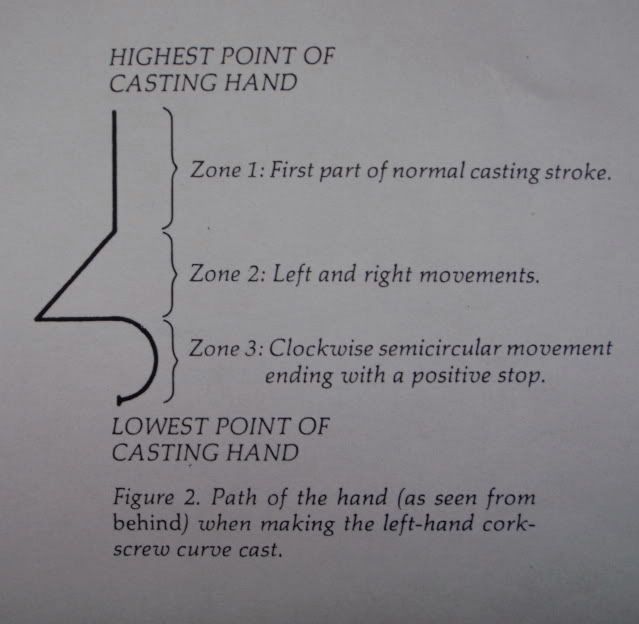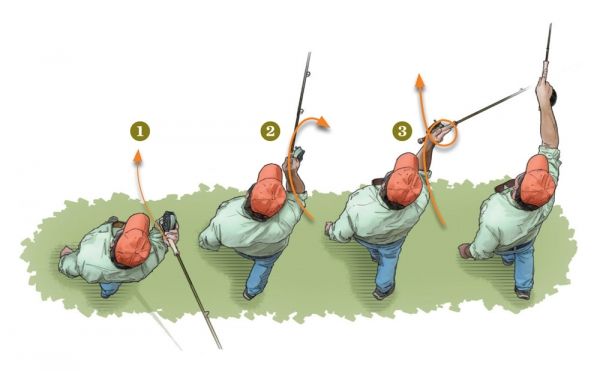When I do the Belgium cast..and check my backcast....the elliptical motion of the rod tip causes an open loop on the back cast. I use it when necessary but don't see how it is beneficial for everyday casting where loop control is important.
By loop control, I assume one aspect of controlling a loop is preventing a tailing loop and getting a "wind knot". The elliptical casts make wind casts impossible. Because the back cast and forward cast are in different planes, the are separated in a three dimensional space and the lines can never cross.
A wind knot occurs because the following fly leg (upper leg) of the casting loop falls below the standing rod leg (lower leg) AND the legs are in the same casting plane. See # 3 below.
BOTH situations must occur, that is the following leg must cross the standing leg and the legs must be in the same plane. A wind knot cannot occur if the two legs of fly line are in different casting planes.
Example - By using an elliptical casting motion, the back cast and forward cast are made in different planes and this separates the two legs of the loop formation. Even if the fly and rod legs of the loop formation cross vertically, they cannot catch on each other because they are separated horizontally in space; they are in different planes.
To see how this works, make a side arm back cast and then an overhead forward cast and you will see than the two legs of the loop are in different planes. Even if the upper fly leg of the loop drops down on the forward stroke, there is no lower rod leg of the loop to get tangle with because there is a horizontal separation of the two legs of the loop.
---------- Post added at 12:53 PM ---------- Previous post was at 12:08 PM ----------
Pro-vertical...
Accuracy
Keeping line off the water or grass when false casting.
Finding range.
Better roll casting for distance and again accuracy.
Can see the line better as an instructor or student.
Can see loops and line behaviour better as an observer.
I totally agree.
I would add that I think it has the simplest casting motion and is the easiest to teach.
It also is the best for distance. The back cast and forward cast are separated by 180 degrees, and this 180 separation allows the energy/momentum of the forward cast to be most efficiently stored in the fly rod for the back cast and vice versa. The fly line is also as far off of the ground for both the back cast and forward cast so it can travel father before hitting the ground (point 2 in Jackster's list). All of these properties make the optimum cast for distance.
Because the vertical cast is the most elevated cast, it keeps the backcast from catching on vegetation behind you on the river bank.
It is also the easiest cast to slip in between vertical obstructions on/in the water or on shore. If you need to slip your backcast in between two trees, you do not want the upper and lower legs of your cast separated horizontally in space.
It is also the cast upon which most of the common in the air mends and specialty casts are built. For example, the reach mend is most effective with a vertical cast. From the vertical stop the caster has the longest time to complete and place complex mends such as curve mends.
The puddle cast, the parachute cast, the tuck cast, the pile cast, the corkscrew curve cast, and the sky curve cast are based on the vertical cast.
For a right handed caster, the corkscrew curve hooks to the left and the sky curve hooks to the right.
Corkscrew Curve Cast:
http://fishfliesandwater.com/casting-mending/corkscrew-curve/
Sky Curve Cast:
[ame=http://www.youtube.com/watch?v=c3ZpPru_CRU]Unbelievable Curve Cast!! Fly Casting / Mahler's Sky Curve - YouTube[/ame]




